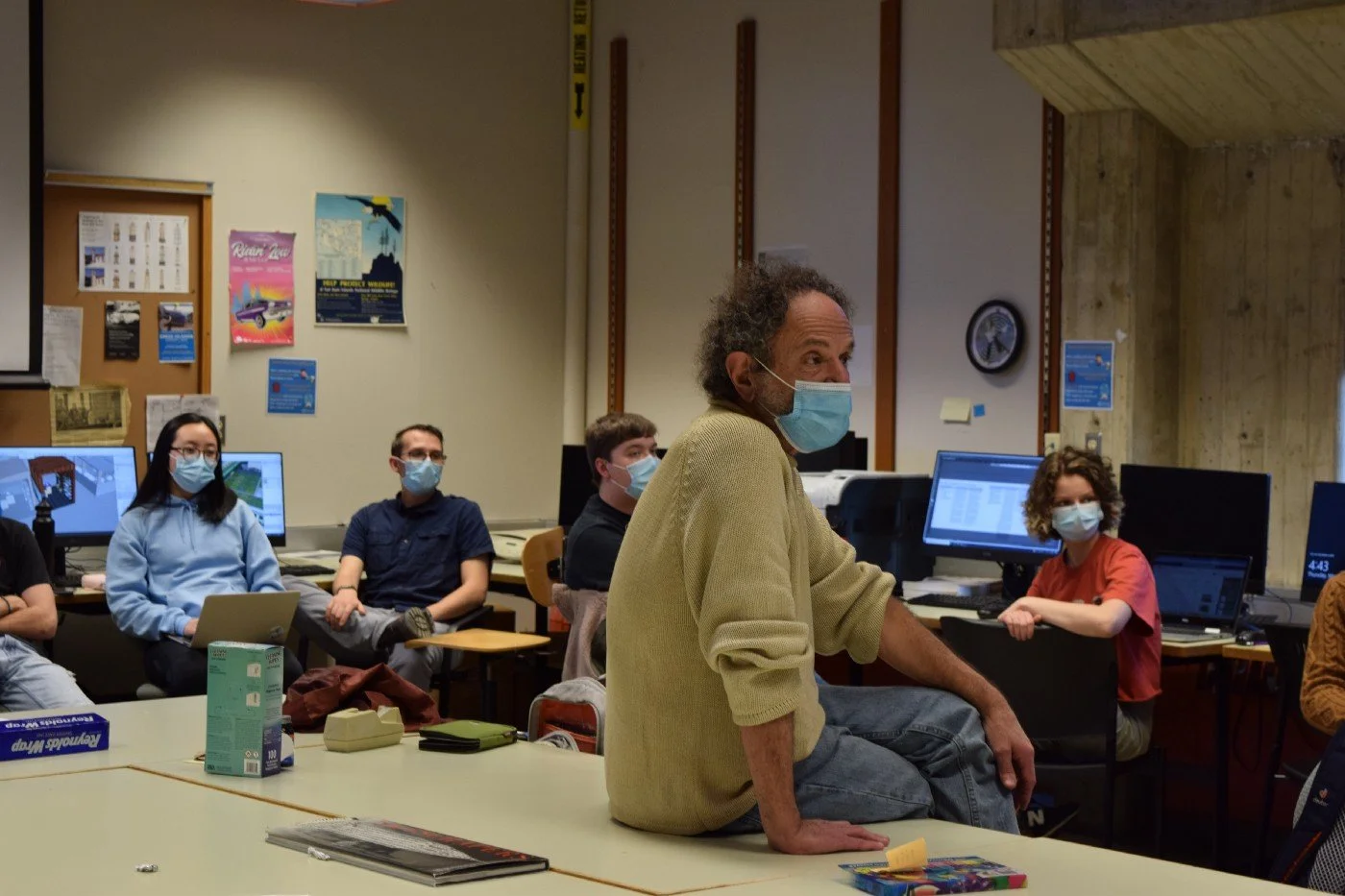Praise the Parklet
The downtown Bellingham streatery scene has exploded since the start of the COVID-19 pandemic. Early city preparation paved the way for the successful rollout.
By Maddie Federici // Photos by Adelle Tower
March 16, 2022
Perched outside the Herald Building entrance on Bellingham’s State Street is a humble wooden platform with two picnic benches and some potted plants — but there’s more to it than meets the eye. The simple structure is a pioneer in city planning, a wandering hometown hero and a quiet icon of the decade.
The so-called parklet is a product of a human-centered urban design experiment done by the City of Bellingham and the nonprofit Sustainable Connections. The project laid the groundwork for a perfectly timed program that helped local businesses survive during the COVID-19 pandemic.
Over the past two years, Bellingham’s downtown streets, once occupied by parking spaces and turning lanes, have become lined with streateries. The new additions have not only changed traffic planning and road use but have proven to be invaluable to businesses’ survival.
This innovation began a decade ago, when the local company Bellingham Bay Builders created the city’s first parklet. Several businesses took turns hosting it outside their establishments until it was purchased and moved to its current home in front of the Herald Building six years ago.
Although the project was well-received by businesses and community members, the city didn’t see an increase in parklet permit requests because they can be expensive to build.
As an incentive, the city streamlined the permitting process for several years and created a comprehensive guide for doing commercial business in a road way, including guidelines for everything from food trucks to sidewalk cafes.
“Coincidentally, that was an effort that was completed in 2019,” said Darby Galligan, senior planner for the City of Bellingham.
Darby Galligan, senior planner for the City of Bellingham. // Photo courtesy of Darby Galligan.
When the pandemic hit in March 2020, that timing paid off. With an outdoor seating program already in place, Bellingham was ahead of most cities in the country in helping businesses adapt to strict safety mandates and rapidly changing pandemic guidelines.
For the local Italian restaurant Storia Cucina, the pandemic postponed their grand opening in March 2020 and shaped their debut in May 2020. They were only able to provide “to-go” service. As a result, Bellingham’s first tastes were served strictly in takeout boxes.
By June, outdoor dining was in action, and the city was expediting restaurant permit requests.
“So many communities were just scrambling,” Galligan said. “I did get contacted by quite a few communities that were like, ‘How did you do this?’ We were just lucky to have the foresight.”
In July of 2020, the city collaborated with the nonprofit Downtown Bellingham Partnership to conduct the Holly Plaza Experiment, another trial run for human-centered urban design. To accommodate businesses in the downtown district needing additional space to meet Washington’s COVID guidelines, they closed the entire block of Holly Street and all driving lanes between Commercial Street and Bay Street for the summer.
“We actually had a limit that no more than 10 parking stalls could be displaced in any particular business district,” Galligan said. “When COVID happened, we lifted that because we knew that those businesses needed the space to survive while their interiors were closed.”
“I feel really, really proud of our community for being creative in problem-solving.”
— Darby Galligan
They expanded the experiment to accommodate other restaurants downtown needing extra capacity, including Storia Cucina, which opened outdoor seating that occupied a lane of Grand Avenue. The restaurant recently scaled back to be within the parking stalls.
“It was interesting because in non-COVID times, I don’t know if it would have ever happened,” Galligan said. “We went from, like, ‘Downtown is kicking ass’ to ‘It’s a ghost town.’ The administration and the mayor were just very supportive of doing whatever we could possibly do to support the businesses.”
The city opened the streets again that fall, but some experimental streateries were allowed to stay if they downsized. The restaurant Black Sheep and the neighboring Lorikeet Bar, located on Holly Street, kept their outdoor seating, occupying the left turn lane and nearby parking spots.
The Black Sheep parklet on Holly Street lights up the night for outdoor diners.
“It was partially because we knew they needed the space in order to survive,” Galligan said. “But it was also because our traffic division recognized that the left turn lane was not critical for traffic flow.”
Mount Bakery and Temple Bar on Champion Street don’t have any parking spots available outside their businesses, so the city rerouted traffic during the block closure for them to have a streatery in the left turn lane, which is still in place.
Although having an outdoor dining program prepared the city for the surge of streatery permit requests early on, figuring out how to make the structures permanent has been a journey.
City experts have worked with businesses on a case-by-case basis throughout the pandemic, learning alongside them and creating policies to follow safety measures and codes as they go. Other communities didn’t have such robust streatery guidance for building and fire codes throughout the pandemic and now lack the streatery program that Bellingham boasts, Galligan said.
“I feel really, really proud of our community for being creative in problem-solving,” Galligan said.
With public support to keep the streateries around long-term, the city has worked with the fire and building departments to create and update safe heating, covering, and electrical system regulations for colder seasons.
“The trickiest part is ensuring that… we’re helping the business owners so that they can survive in this really challenging time,” said Ron Richard, Fire Marshal at the Bellingham Fire Department. “We can’t lose track of the safety of the public that’s going to be utilizing that space, too. It’s been a balancing act in trying to do the right thing so that all parties are looked after properly.”
Their main concerns have been mitigating fire-risk and ensuring proper ventilation to reduce carbon monoxide exposure, Richard said.
Despite business interest, there are barriers for some businesses wanting to build their own streateries. Not only are they expensive, but for many, it isn’t feasible at their location, said Lindsey Payne Johnstone, program director at the nonprofit Downtown Bellingham Partnership.
“Some businesses may not feel like they have the same opportunity if they’re not in a position or don’t have an area on their block where they could do that,” Johnstone said.
There have also been grumbles about the fairness of businesses using parking spots downtown as traffic has gradually picked up over the last year.
“Places for people are a priority over places for cars, in our view,” Galligan said. “But for the time being, the city does have a strong policy direction around using public space equitably, with a priority on pedestrians. So, until such time we need to revisit that, we’re going to continue to allow [streateries].”
Notably, outdoor dining isn’t allowed to use or displace handicap parking stalls. Although finding parking right outside a destination isn’t always guaranteed, there are several paid lots and two parking garages available downtown, and all parking is free after 5 p.m.
“If there are traffic issues, we hear from the public about it,” said Chris Beyer, traffic technician for the City of Bellingham, in an email response. “There have been relatively few that we are aware of and they were mainly in the beginning. Change is initially hard, but people adapt.”
With streateries here to stay, businesses will likely want to establish outdoor dining options out of interest rather than necessity.
“If folks want to continue to keep their parklets, or if businesses have ideas for new ones, it’ll be less attached to the emergency response of COVID and more about the fun, unique aspect of adding something like that to their business model,” Johnstone said. “I’m excited to see how that can take a turn.”
Storia Cucina owner Jonathan Cicotti said he imagines their streatery as a “mini-Tuscany.” He envisions their block as a haven for pedestrians: closed to car traffic, a painted street, large planters replacing detour signs, and bike racks and outdoor dining filling the space.
Storia Cucina’s outdoor streatery on Grand Avenue.
Urban planning students at Western Washington University are finalizing a project with a similar vision, working with the City of Bellingham, Whatcom Transit Authority and the Downtown Bellingham Partnership. Their plan implements human-centered design throughout a five-block corridor of Railroad Avenue, right in the heart of downtown Bellingham.
This type of integrated land use where private business activity seeps into outdoor public spaces is common in Europe and has been successful in other U.S. cities, said Nicholas Zaferatos, professor of urban planning and development at Western’s College of the Environment.
The pandemic has inspired a strong and widespread sentiment in Bellingham and throughout the U.S. to support small businesses and invest in local communities. Streateries and parklets provide low-risk opportunities for entrepreneurs to become business owners, Zaferatos said.
Zaferatos speaks to urban planning students during a class at Western Washington University.
“Imagine how the public sphere, which is now parking lots and parking spaces and roads, could further enhance whatever the demand is — the music industry, the arts industry, the food industry, the jewelry making industry, all of that stuff,” Zaferatos said. “Are we too limited in terms of what we’re thinking about today as a streatery? Where can it go? I think it represents something bigger.”
One thing is certain — streateries have made their mark on Bellingham. Next time you pass the parklet on State Street, give thanks and stay awhile.
Maddie Federici is a senior environmental journalism student using storytelling to highlight community change and resilience.




